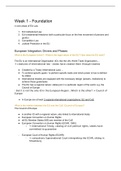Summary
EU law Summary (week 1-6) + Recap for Exam
- Course
- Institution
The document contains a summary of all lecture and reading notes for weeks 1-6 of EU law. At the end of the document are some steps for the analysis that is required in the midterm exam. The topics included are: Week 1 - Foundation, Week 2 - The Legislative Function in the EU, Week 3 - The effe...
[Show more]



